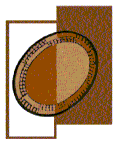by Elisabeth Braun
The Owambo women of the early twentieth centry knew how to wear their
traditional ornaments with pride and style.
One of their most treasured jewels was a decorative button called the ekipa.
Carved out of ivory, it came in many shapes and sizes.
The number of ekias displayed by an Owambo woman conveyed her status
in the community and gave an immediate indication of the wealth of her
husband or her family.
In addition to ornamental value,
the ekipa thus also had economic significance.
There is no exact information available about the origin of ekipas.
Experts believe they first appeared at the end of the 19th
century and were worn by the wives and daughters of the
Kwanyama chiefs and headmen in southern Angola.
There is also evidence that ekipas were used as money,
paying for food and other necessities the Kwanyama purchased from
neighboring Owambo tribes in Northern Namibia.
In the 1920s, elephant hunters are said to have traded ivory with
Kwanyama chiefs.
The elephant tusks thus obtained were cut into workable sections and then
buried for several weeks in urine-drenched earth in order to create
the favoured brownish-yellow colour of the ivory.
Owambo carvers then shaped the ekipas into oval, round, square, multi-cornered,
or oblong forms.
They were usually 2 to 10 cms long and 1 to 5 cms thick.
All ekipas had a slightly raised, rounded, or smoothly pointed
center which resembled the top of a tiny beehive.
Although ivory ekipas were preferred, some were also fashioned out of
hippopotamus tooth or bone, and less often out of wood or the fruit
of the Makalani palm.
Ekipas were also engraved with a border, or borders, in different
geometric patterns around the outer edge.
The most frequent designs were criss-crossed or tightly squared lines
in the form of blocks edged with two strong horizontal lines.
It is not known whether the patterns had specific meanings; they might
simply have reflected the creative fancy or ingenuity of the artist.
After the ekipa had been carved, it was polished with sand stone
and rubbed with an aloe extract to highlight the carved lines in a
darker colour.
The entire button was then treated with okalula powder.
A red, ochre-like substance gathered from dolf wood,
the powder penetrated the ivory and reinforced the red-brown
patina of the ekipa.
Two small holes were carved on the underside of the button,
large enough for a thin leather strip to be pulled through.
Thus the ekipa could be fastened to different objects and materials or
could be displayed on parts of the body.
Owambo woman preferred to wear the ekipas around their upper arms or necks,
or to let them hang down their uncovered backs on a
strip of soft leather or fibre,
fastened to a strong neck piece.
The most common display was on a long sturdy strip of dyed elephant hide,
hanging from an equally sturdy leather belt around the women's waist,
with each ekipa fastened to the leather,
one beneath the other in a sequence of as many as twelve.
On special occasions, such as a young girl's initiation or wedding
(enfundula), no effort was spared to display the full splendour
of the ekipas.
With the arrival of Western missionaries in the remote lands of Owambo,
the delight in tribal decoration and the acceptance of the naked
body slowly disappeared.
Since it was considered unfitting to a Christian image,
women's bodies were now covered in Western garments.
Traditional ornaments began to lose their meaning.
Quickly assessed as a soon-to-be-extinct art form,
collectors began to acquire ekipas.
Many of the finest examples are now in private collections.
In 1991, Claus Ruehland of Windhoek donated a fine collection of about
300 pieces to the Swakopmund Museum on the occasion of its 40th
anniversary.
Ruehland, who became interested in ekipas in the early 1980s,
acquired his first collection from a missionary in 1983.
His private collection now consists of some 800 ekipas.
Ruehland tells an interesting story about a 1930s photograph he
used to illustrate a display of ekipas in a window of his curio shop
Omatako in Windhoek.
"It showed three Owambo women," he remembers.
"Each was adorned with at least a dozen ekipas.
The three were walking behind a fourth woman.
One day a stately Owambo woman came into the shop and wanted to know
where I had found the photograph.
She said she remembered the occasion when it was taken and
recognized the women in it as her mothers.
Mothers?
Yes, she said, the woman walking alone was her natural mother;
the three women following her were her father's other wives,
and therefore also her mothers.
The woman looked at the photograph for a long time and then left.
I have never seen her again."
If the number of ekipas shown in the photograph represented the wealth of
one man,
Ruehland speculates, the inquiring woman's father must have been very rich,
since he could afford to provide four wives with ekipas.
Ekipas are no longer made for Owambo women, but can still be found
in specialty shops in Windhoek and Swakopmund.
Some have been fashipned into exquisite pieces of jewellery and are
often encased in stunning contemporary gold and silver settings.
Since 1989, a worldwide ban prohibits trade in ivory,
so bone or wood ekipas have found favour in Europe.
They are magnificant small treasures speaking of a time of
traditions almost lost.
The remainder of this page provides various logos of the NCCI. They are available for your convenience, should you wish to provide a link from your own home page back to this site.












Copyright ©
1998-2001 Namibia Chamber of Commerce and Industry.
All Rights Reserved.
Site Version 1.04 -
Last updated November 6, 2001.